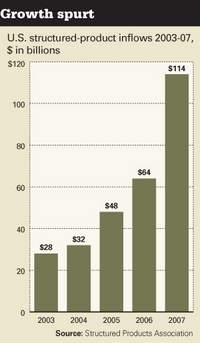By Paul O'Dowd
Published: July 7 2008
Structured products, long popular in Europe, are now taking hold in the US as markets spook investors and baby boomers look to protect their wealth. Last year, assets in structured products climbed to $114bn (£57bn, €72bn) in the US, up from $64bn in 2006, according to the Structured Products Association.
Last year, Merrill Lynch was the top issuer with $6.1bn in sales followed by Citigroup with $3.1bn, Morgan Stanley with $3bn, Barclays with $2.6bn and UBS with $2.3bn. These numbers represent the above firms selling only their notes and not competing firms' notes.
Some examples of structured products are: principal-protected notes, index-linked notes, performance-leveraged upside securities and reversed-convertible notes.
This year's inflows are so far keeping pace with last year, says Philippe El-Asmar, head of solution sales for the Americas at Barclays.
Structured products, formerly investments mainly for the wealthy, have since come down-market and are now available in the retail space.
Generally these products are created by combining or snapping-on additional financial products to a traditional security, such as a bond.
These snap-on products can be selected to have low correlation to the underlying investment, which gives the advantage of increasing diversification of the final structured product. If one component of the structure deteriorates, other components will serve to offset or dilute this loss, providing a safety net to investors.
The primary driver behind the high inflows into structured products seems to be that brokers and registered investment advisers (RIAs) are embracing the investment for the first time.
For the full article in Financial Times, click here.
Monday, July 7, 2008
Subscribe to:
Post Comments (Atom)




No comments:
Post a Comment